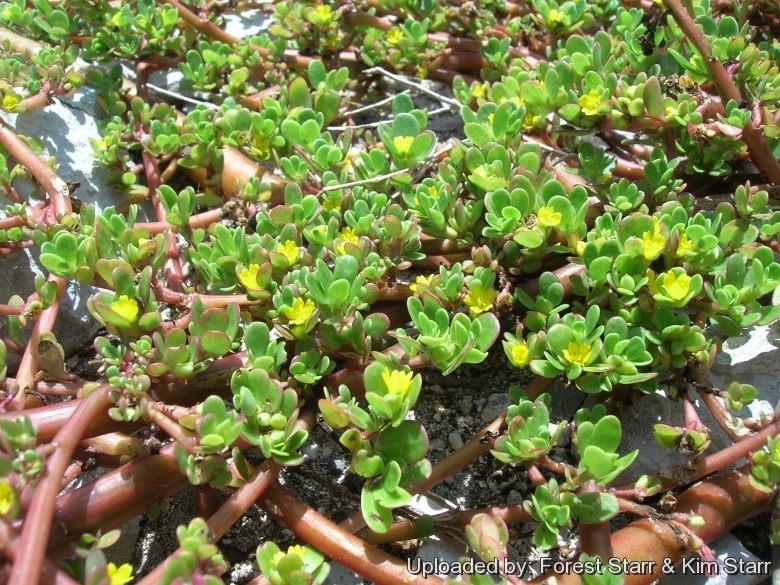
Portulaca oleracea Photo by: Forest Starr & Kim Starr
Flowering habit at Runway overrun fields Sand Island, Midway Atoll, Hawaii (USA). June 02, 2008.
Origin and Habitat: Portulaca oleraceaSN|29334]]SN|29334]] maybe of ancient Asian origin is a cosmopolitan weed of temperate and tropical regions widespread in Africa, Europe and Asia through the Middle East and the Indian Subcontinent to Malesia and Australasia, it is also present but less common in North America. The species status in the New World is uncertain: in general, it is considered an exotic weed, however, there is evidence that the species was in Crawford Lake deposits (Ontario) in 1430-89 AD, suggesting that it reached North America in the pre-Columbian era. It has long been in cultivation in some European countries as a vegetable and now it is naturalised elsewhere and in some regions is considered an invasive weed.
Altitude range: 0–2500 metres above sea level.
Habitat and ecology: Portulaca oleraceaSN|29334]]SN|29334]] is a common annual weed of cultivated fields, gardens, railway tracks, and roadsides. It is very widespread in sandy waste places in warm climates.
Synonyms:
See all synonyms of Portulaca oleracea
Common Names include:
ENGLISH: Little hogweed, Red root, Moss rose, Verdolaga, Pigweed, Common Purslane, Garden purslane, Purslane, Purslave, Wild water-leaf (Nigeria), Pursley
ARABIC ( لعربية ): البَقْلَة اللَّيِّنَة, البَقْلَة, بقلة حمقاء, الرُجَيْلَة, الفَرْفَح, الفَرْفَحَى, الرِجْلَة, الفُرْفِير, الفَرْفَحِين
AZERBAIJAN ( Azərbaycanca): Dirrik pərpərəni
BAMBARA (Bamanankan): , missi kumbéré, taf a nuk, tiaf a nuk
BASQUE (Euskara): Ketorki, Ketozki, Getozka, Getozca
BELARUSIAN (Беларуская): Партулак агародны
BULGARIAN (Български): Тученица
CATALAN (Català): Verdolaga
CHINESE (中文): 马齿菜、五行草、酸苋、猪母菜、豬母乳、地马菜、马蛇子菜、长寿菜、老鼠耳、寶釧菜、蚂蚱菜, 马齿苋
CORSICAN (Corsu): Erba fratesca
CROATIAN (Hrvatski): Tušt
DHIVEHI (ދިވެހި): ގެދަ
DUTCH (Nederlands): Postelein
FINNISH (Suomi): Vihannesportulakka
FRENCH (Français): Porcelane, Pourpier maraîcher, Pourpier, Portulache
GERMAN (Deutsch): Portulak, Gemüse-Portulak
GREEK (Ελληνικά): Αντράκλα, ανδράχλη, γλυστρίδα
HAITIAN CREOLE (Kreyòl ayisyen): Koupye
HEBREW (עברית): רגלת הגינה
HUNGARIAN (Magyar): Kövér porcsin Ez a lap egy ellenőrzött változatarészletek megjelenítése/elrejtése
ICELANDIC (Íslenska): Súpugull, Portulakka
IDO: Portulako
INDONESIAN (Bahasa Indonesia): Gelang biasa
ITALIAN (Italiano): Porcellana comune
JAPANESE (日本語): スベリヒユ
KAZAKH (Qazaqşa / قازاقشا / Қазақша): Бақша қараоты
KOREAN (한국어): 쇠비름
KURDISH (كوردی / Kurdî): Pêrpîne, Pêpîner, Pirpar
LATIN (Latina): Portulaca
LIGURIAN (Líguru): Purselana, Porcellana, Procaccia
LOMBARD (Lombard / Lumbaart): Erba grassa
MALAY (بهاس ملاي /Bahasa Melayu ): Gelang pasir, Rumput beremi, Segan jantan
MALAYALAM (മലയാളം): കൊഴുപ്പ
MARATHI (मराठी): घोळ
MAZANDERANI (مازِرونی): پرپین
NAVAJO (Diné Bizaad): Tséghániłchʼi
NEAPOLITAN (Nnapulitano): Përcaglia, Përcacchia
OSSETIAN ( Ирон æвзаг - Iron ævzag): Цæxдонгæрдæг
PERSIAN (فارسی): خرفه پرپهن
PIEMONTES (Piemontèis): poslan-a
POLISH ( Polski): Portulaka pospolita
PORTUGUESE (Português): Beldroega, Bredo-femea, Baldroaga, Beldroega comum, onze-horas, Ora-pro-nobis, Caaponga (do tupi), Salada-de-negro
ROMAGNOL DIALECT (Rumagnòl): Pan cot
ROMANIAN (Română): Iarbă grasă
RUSSIAN (Русский): Портулак огородный
SARDINIAN (sardu): Barzellana
SERBIAN (Српски / Srpski): Тушт
SICILIAN (Sicilianu): Purciddana, Purciaca
SPANISH (Español): Tarfela, Verdalaga, Verdulaga, Verdolaga, Verdolaga romana, Verdolaga real, Verdolaga hortense, Flor de un día (Argentina), Flor de las once (Colombia), Colchón de niño (Salvador), Peplide, Buglosa, Hierba grasa, Verdolaga colorada, Verdolaga silvestre, Porcelana, Verdolaga española, Verdolaga común, Lega (Argentina), Borzolaga, Engañagochos, Lengua de gato, Loraca, Malmuere, Nuncamuere, Portulaca, Verderaja, Verdolaga angosta, Verdolaga blanca
SWEDISH (Svenska): Portlak
THAI (ภาษาไทย): คุณนายตื่นสาย
TONGA (Chitonga or Zambezi): Tamole
TURKISH (Türkçe): Semizotu
UKRAINIAN (Українська): Портулак городній
UPPER SORBIAN (Hornjoserbsce): Jědźny portłak
UZBEK (Oʻzbekcha / أۇزبېك ﺗﻴﻠی / Ўзбек): Semizoʻt
VIETNAMESE (Tiếng Việt): Rau sam
WOLOF (Wolof): tãnk i m, tang i mpiteurh, tâg i mpitöx, tanguipeter
ZAZAKI (Zazaki): Parpar, Pımpar, Pumpar, Pırpar
Description: Portulaca oleraceaSN|29334]]SN|29334]] is a annual glabrous rather fleshy succulent herb forming a spreading mat, or infrequently ascending. The bright yellow flowers have five regular parts and usually are less than 8 mm wide wide. Portulaca oleraceaSN|29334]]SN|29334]] is a highly variable species.
Stem: Branches spreading or prostrate, smooth, up to 30(-55) cm long and up to 5 mm in diameter often reddish, trichomes at nodes and in inflorescence absent or inconspicuous, old stems glabrescent.
Root: Taproot 2-10 cm long.
Leaves: Alternate to subopposite on the branchlets, and often somewhat crowded towards the ends of the branches, green or flushed red, sessile or shortly stalked, (4-)5-28(-309 mm long (2-)3-12(13) mm wide, narrowly obovate to spathulate, flattened, apex rounded or truncate, base more or less attenuate into obscure petiole 1–3 mm long, stipular hairs very few, inconspicuous, caducous, about 0.6–1 mm long, often soon lost.
Flowers: Bright yellow, 6-10 mm wide, terminal, sessile, solitary or up to 5, surrounded by a cluster of 1-4 subverticillate leaf-like bracts and an inner whorl of triangular membranous scales, ca. 3 mm long, ovate-acuminate. The flower cluster often apparently lateral or in fork of branch because of overtopping by later growth. Sepals (2–)3–4.5(–5.5) mm long, united below into a tube 2 mm long, free portions fleshy, oblong-ovate, keeled or winged along the midline upwards. Petals dull yellow (very rarely pale pink), (3-)4–8 mm. long, united at the base, obovate-oblong to obovate, tip rounded, sometimes emarginate or bilobed. Stamens 7–12. Ovary ovoid; style short, with 3–6 subulate lobes.
Blooming season: Depending upon rainfall, the flowers appear at anytime during the year. The flowers open singly at the center of the leaf cluster for only a few hours on sunny mornings.
Fruit (capsules): Obovoid to ovoid, enveloped in the marcescent corolla, splitting near or just below middle; lid hemispherical/conical, chartaceous, constricted 2/3 up, usually with narrow, more strongly veined extension at tip which retains a few seeds within it.
Seeds: Many, c. 0.5-1 mm long, glossy dull black with no metallic sheen, reniform. Testa cells stellate with a conspicuous central tubercle, papillae few or absent; seed periphery tuberculate.
Chromosome number: 2n =54
Subspecies, varieties, forms and cultivars of plants belonging to the Portulaca oleracea group
Portulaca oleracea is a polyploid complex, with diploid, tetraploid and hexaploid forms (2n = 18, 36, 54). Danin et al. (1978) divided the complex into seven subspecies on the basis of seed size and patterning, relating these to different ploidy levels: subsp. oleracea, subsp. impolita Danin & H. G. Baker, subsp. granulatostellulata Danin & H. G. Baker, subsp. nicaraguensis Danin & H. G. Baker, subsp. nitida Danin & H. G. Baker, subsp. papillatostellulata Danin & H. G. Baker, and subsp. stellata Danin & H. G. Baker. The subspecies are not geographically separated, and even within the same flora area it is possible to recognise several of these seed types, which sometimes grow together. P. oleracea (purslane) has been used as a vegetable since ancient times. The cultivated form, subsp. sativa (Haw.) Celak, distinguished by larger seeds over 1 mm long, is probably a selection from subspecies oleracea.
Bibliography: Major references and further lectures
1) Forest & Kim Starr “Portulaca oleracea (Pigweed)”. Plants of Hawaii. <http://www.starrenvironmental.com>. 23 Oct. 2014.
2) Tetyana Vekslyarska “Ploidie- und Samengrößenvariation im Portulaca oleracea-Aggregat” Diplomarbeit Universität Wien, 2011 on line <http://othes.univie.ac.at/17067/1/2011-11-22_0509094.pdf>
3) GREUTER, W., M. BURDET & G.LONG (1989). “MED-CHECKLIST.” [vol. 4] Conservatoire & Jardin botaniques de la Ville de Genève. [p.369]
4) CASTROVIEJO S. & al. (ed.) (1990). "Flora Iberica." vol. 2. Real Jardín Botaníco, C.S.I.C. Servicio de Publicaciones. Madrid. [p.468]
5) Fl. Eur., ed. 2 1: 138 (1993).
6) BOULOS, L. (1999). "FLORA OF EGYPT." [vol. 1] Al Harara Publishing. Cairo. [p.50]
7) FENNANE, M., M. IBN TATTOU, J. MATHEZ, A. OUYAHYA & J. EL OUALIDI (éd.) (1999). "Flore pratique du Maroc." vol. [1] Trav. Inst. Sci., Série Bot. 36. Rabat. [p.175]
8) H. Wild “Flora Zambesiaca” FZ, Vol 1 Part 2, page 362 1961
9) M. G. Gilbert “Flora Somalia”, Vol 1 1993 [updated by M. Thulin 2008]
10) SYLVIA M. PHILLIPS “Flora of Tropical East Africa” 2002
11) Burkill, H.M. “The useful plants of west tropical Africa,” Vol 4 1985.
12) Flora of North America Editorial Committee. “Flora of North America, volume 4” Oxford University Press, New York. 2003.
13) DANIN, A., I. BAKER & H. G. BAKER (1979). “Cytogeography and Taxonomy of the Portulaca oleracea polyploid complex.” Israel J. Bot. 27: [177-211]
14) Wikipedia contributors. "Portulaca oleracea." Wikipedia, The Free Encyclopedia. Wikipedia, The Free Encyclopedia, 20 Oct. 2014. Web. 8 Nov. 2014.
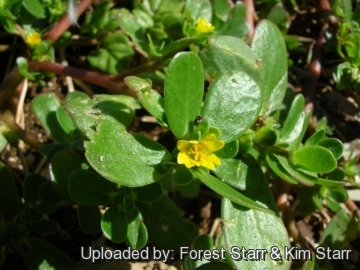 Flower at Mokuauia, Oahu, Hawaii (USA). February 22, 2005. Photo by: Forest Starr & Kim Starr
Flower at Mokuauia, Oahu, Hawaii (USA). February 22, 2005. Photo by: Forest Starr & Kim Starr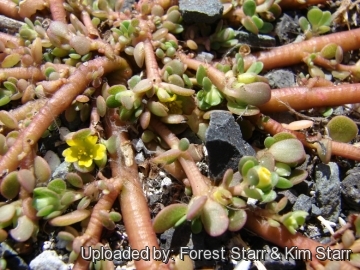 Flowers stems and leaves at South Beach Sand Island, Midway Atoll, Hawaii (USA). June 04, 2008. Photo by: Forest Starr & Kim Starr
Flowers stems and leaves at South Beach Sand Island, Midway Atoll, Hawaii (USA). June 04, 2008. Photo by: Forest Starr & Kim Starr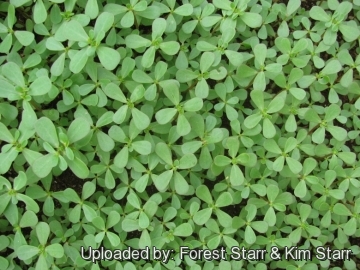 Many seedlings at Kaukaukapapa, Kahoolawe, Hawaii (USA). December 27, 2010. Photo by: Forest Starr & Kim Starr
Many seedlings at Kaukaukapapa, Kahoolawe, Hawaii (USA). December 27, 2010. Photo by: Forest Starr & Kim Starr Habit at Mokeehia, Maui, Hawaii (USA). April 04, 2005. Photo by: Forest Starr & Kim Starr
Habit at Mokeehia, Maui, Hawaii (USA). April 04, 2005. Photo by: Forest Starr & Kim Starr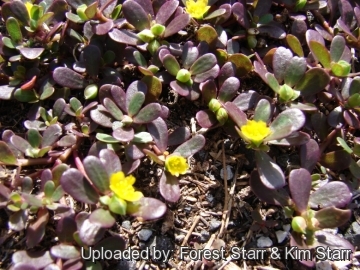 Flowering habit at Flag field Sand Island, Midway Atoll, Hawaii USA). June 12, 2008. Photo by: Forest Starr & Kim Starr
Flowering habit at Flag field Sand Island, Midway Atoll, Hawaii USA). June 12, 2008. Photo by: Forest Starr & Kim Starr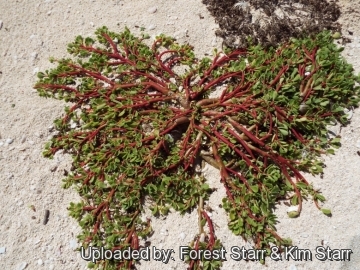 Habit with corky and red stems larger leaves at North Desert, Laysan, Hawaii (USA). September 14, 2013. Photo by: Forest Starr & Kim Starr
Habit with corky and red stems larger leaves at North Desert, Laysan, Hawaii (USA). September 14, 2013. Photo by: Forest Starr & Kim StarrCultivation and Propagation: Portulaca oleraceaSN|29334]]SN|29334]] is an aggressive weed that spreads in garden and fields with worldwide distribution in temperate to warm regions and one of the ten most noxious weeds worldwide. It is also the most winter-hardy of all the portulacas. It can spread and even travel as vegetative fragments which are tolerant of salt water and root easily everywhere on landing. It is occasionally grown as a food, Simopoulos et al. (1992) have shown Portulaca oleraceaSN|29334]]SN|29334]] to have the highest content of omega-3 fatty acids and antioxidants of any green leafy vegetable examined to date, suggesting that common purslane should be considered for its nutritional value and not for its weediness, but not been widely cultivated . It requires sunlight and well-drained soils but is an extremely adaptable plant. Although it survives difficult conditions, plants will produce more lush growth when provided sufficient moisture and rich soils.
Soils: It grows well almost in every kind of soil comprising poor, sandy or gravelly soils
Exposure: Needs full sun to half-shade.
Waterings: Drought tolerant, but grows best with regular watering. Once plant is well established, allow them to dry out between waterings. This plant naturally grows in harsh, dry conditions and does not like wet feet, that is constant moisture in the root area.
Hardiness: Plant seeds or set out moss rose plants after all danger of frost has passed.
Pests and diseases: It is prone to attacks by slugs, ants, mealy bugs, scale, thrips, spider mites, aphids, and root mealy bugs. . These succulent plants need a well drained soil.
Edible Uses: The edible shoots are gathered from the wild for local consumption.
Young shoots are rich in vitamin and cooked and eaten as a potherb. It can also used rough in mixed salads.
medicine uses: It is uses for cutaneous, subcutaneous parasitic infection; dropsy, swellings, oedema, gout; kidneys, diuretics; pregnancy, antiaborifacients; pulmonary troubles; skin, mucosae; stomach troubles; venereal diseases.
*Propagation: *By Seeds or cuttings. To clean the seeds, air dry them at room temperature in a bowl or paper bag. Carefully rub the capsules through a strainer with the appropriate size mesh. Sow the seeds on the surface of a pre-moistened well draining mix. Germination takes about 2 to 3 weeks. In warm climates, Portulaca oleraceaSN|29334]]SN|29334]] self-seeds, stablished plants can also be propagated by tip cuttings. Cuttings should be 5 to 12 cm long and the lower leaves should be removed. Sterile potting mix can be used as a rooting medium. The cuttings should be watered daily. They will root in a couple of weeks.

















